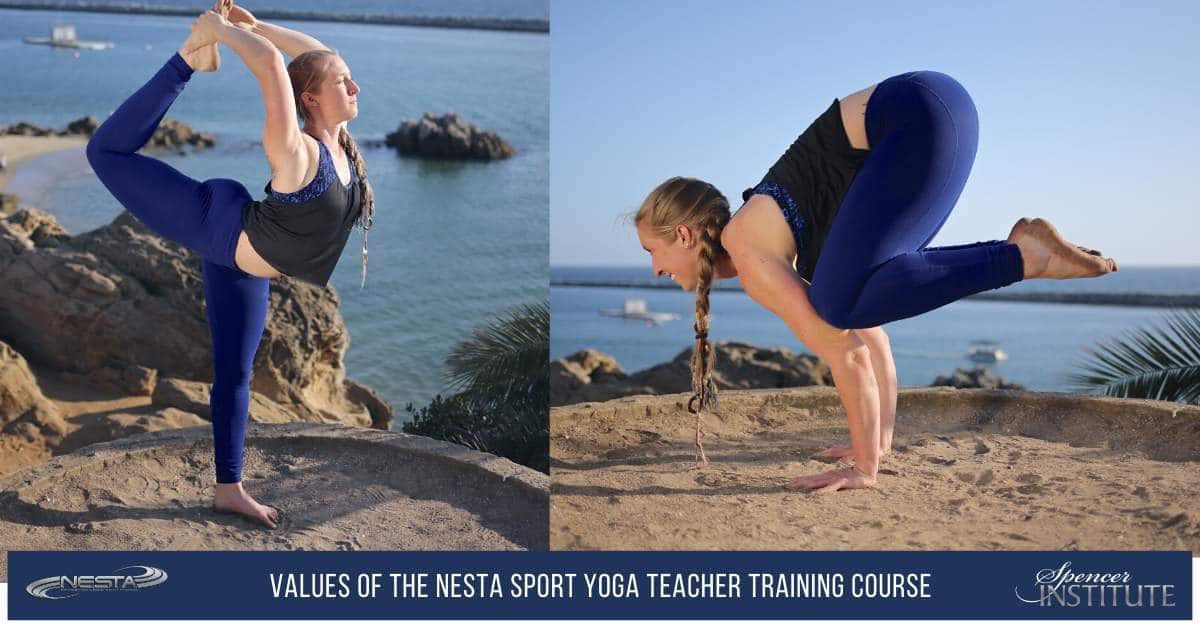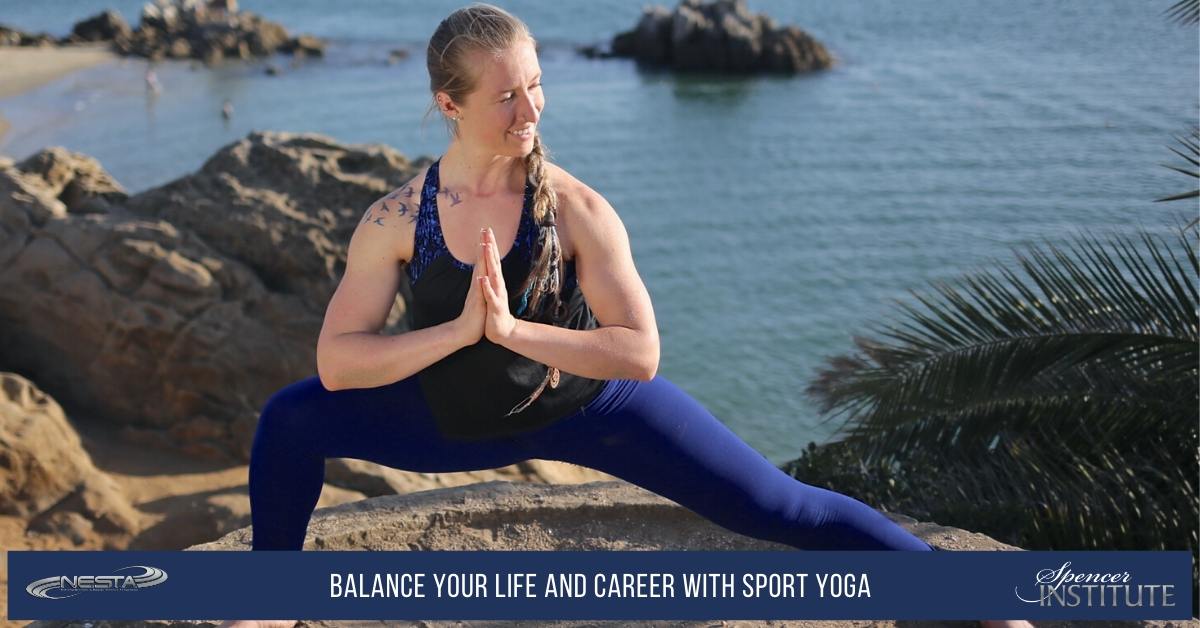Yoga Principles. Practice. Postures. Profession.

The top values of this Sport Yoga program are movement leadership, somatic longevity, and mental flexibility. Every pose and movement is an opportunity to create a greater relationship with yourself, and to guide your students towards doing the same. It is important to note that the postures will be different to every student due to the amazing variety of movement potential each individual has. As an instructor, you have the opportunity to see the characteristics of the student’s body structure and make a guided decision towards a posture that is beneficial for them. Also, it is important for the student to intentionally bring awareness into their own mind so they can develop movement leadership, somatic longevity, and mental flexibility as well. There are two general guidelines that students can follow during their own introspection of the posture experience: Sthira and Sukha.
Sthira and Sukha are two Sanskrit concepts from The Yoga Sutras of Patanjali. In Sutra 2.46, it states “Asana (posture) is a steady, comfortable posture.” Sthira is a Sanskrit word that means to have steadiness and stability. Sukha is a Sanskrit word that means with easy and comfort. Yoga postures must be both steady and comfortable; then the student has earned success within the posture. This is important and related to Sport Yoga because it allows students to tune into the present moment of sensation within their body, and gives them opportunity to become capable at directing their movement in the direction they know will be best. Steadiness and stability in a posture represent a strong neural muscular connection and ability to engage and strengthen the tissue used in a movement, contributing to the overall functional foundation of their body mechanics. Additionally, comfort and ease in a posture represent the mental aspect and ability to stay focused and in a balanced state, not overly controlled by emotions. In Sport Yoga, Sthira and Sukha can be applied as guidelines for the student to understand their experience of the posture.
By using verbal cues guiding toward both Sthira and Sukha, you can direct your Sport Yoga students to help transform their Yoga practice towards one with much more introspection and speculation of each posture. If there is discomfort or panic in a posture, it could be a somatic communication of a range of motion not currently accepted by the student’s nervous system, and therefore moving into a more comfortable, neutral posture will be a good idea! The outcome is for your Sport Yoga students to move (quite literally) towards their goals, and by increasing their own personal body experience and awareness, they will earn knowledge that will allow them to continue on the path of those goals.
The Eight Limbs of Yoga
For thousands of years, Yoga was passed down as an oral tradition, from teacher to student, until the Yoga Sutras became a written source text that would become one of the most widely used foundations of Yoga philosophy and structure towards what Yoga is, and what the practices are to enter into a state of Yoga.
The Yoga Sutras of Patanjali is a collection of 196 observations and wisdoms towards the theory and practice of Yoga. The sage Patanjali gathered this information from the ancient Yoga practices and organized them into a collection of aphorisms in Sanskrit, which has over the years been translated to the English language for reference to modern day life and Yoga practice. The Yoga Sutras state about the Eight Limbed Path of Yoga, which can help lead an individual to a purposeful, ethical, and blissful life. These are basic principles of life a Yoga practitioner can observe in every moment to continue into their own path of awareness and enlightenment.
As a Sport Yoga instructor, the Eight Limbs of Yoga can be beneficial both in the way you approach your classes and the way you approach your life. Yoga is in the mind; the physical postures are in the body. Yoga is having the mental fortitude to continue on your clear, illuminated path towards peace under all circumstances. This summary of the Eight Limbs is only the top layer of the continuous, everlasting journey that can be experienced through Yoga. Use these gems of Yogic insight as an opportunity to transcend the physical practice of moving your body, and into the deeper journey of life neuroplasticity training and life purpose.

The Eight Limbs of Yoga are:
1) Yama
The Yamas are the morals and restraints one should have to achieve harmony with one’s self and others.
Ahimsa – nonviolence
Satya – truthfulness
Asteya – non-stealing
Brahmacharya – energy balance
Aparigraha – non-possessiveness
2) Niyama
The Niyamas are the ethical actions one should practice to find internal balance.
Sauca- cleanliness
Santosa – contentment
Tapas – austerity
Svadhyaya – self-study
Isvara Pranidhana – surrender to the higher principle of the universe
3) Asana
The word asana is translated as “seat,” and is referring to the physical postures of Yoga practice. These are the physical movements and positions one experiences in a Yoga class, the down dogs, the lunges, backbends, etc. The postures are in the practice of Yoga to create stimulation to the body to promote balance and strength. Then, meditation can be much more attainable when the body is less restless. The asana practice is for preparation of deeper Yoga, so now you can see that Yoga is much greater than just physical movement!
4) Pranayama
Pranayama is the practice of controlling one’s breath, to gain a steady composure of the mind. It is translated as “vital energy expansion.” There are dozens of different breathing exercises, all based upon the four stages of breath: inhalation, retention, exhalation, retention. Breath is life! Breath practices both strengthen lung capacity and diaphragmatic muscles to expand breath potential and expand life force capacity. Attention to breath is one of the more emphasized principles of Yoga, and consistent commitment to intentional breath work will result in many benefits to the physiological processes of the body.
5) Pratyahara
As you observe your thoughts now, you might notice that you can THINK about your thoughts, can’t you? This is pratyahara, the practice of withdrawing from the external circumstances, to attend to the present perception of the internal environment. In Yoga, you can learn to tune your subjective reality towards a greater amount of neural stimulus responses thinking about the perception of your current state of mind. Notice what your beliefs are, your values, your opinions, desires, aversions, lifestyle, and the “prescription” of the “lens” you see through. Gain a greater understanding of what your body feels like, your heartbeat, or the sensation of taking ten deep breaths. This happens by focusing the thought pattern to an internal writing about YOU. Allow yourself to take a more expanded view of your life, dissociated and outside of you, looking in and observing your own unique and creative model of the world.
6) Dharana
To hone your focus and internal environment towards one object of concentration is the practice of Dharana, the stage of the Eight Limbs where it can be said the “inner Yoga” begins! The internal observations are focused into one specific experience of your current subjective reality. For example, one could focus on a single point in the body, such as the big toe, hands, a point between the eyebrows, heartbeat, or any other internal experience. The mental focus could also be on a single word or group of words, often called mantras. The key in Dharana is to concentrate on one thing, and all the external circumstances are essentially defocused on to allow one to enter states of meditation for continuing the path of Yoga.
7) Dhyana
Continued, unbroken Dharana (concentration) will lead one to experience Dhyana, referring to the concept of meditation. The thought patterns and the current state of being are highly focused on one internal experience, and the external circumstances are temporarily unfocused on to allow for an individual to understand this stage of the Eight Limbs and experience the practice of Yoga.
8) Samadhi
The final stage of the Eight Limbs of Yoga is the absolute and complete absorption of the one practicing meditation into the actual meditation itself, the moment where the observer and object combine to experience the ultimate reality of “oneness.” A practice that transcends words and is available to the ones willing to move towards it, it is the egoless, blissful state of union within Yoga and life.
Here’s where you can get details about becoming a Certified Sport Yoga Instructor.
This in-depth article shows you exacly how to have a thriving yoga business without a gym or studio.






